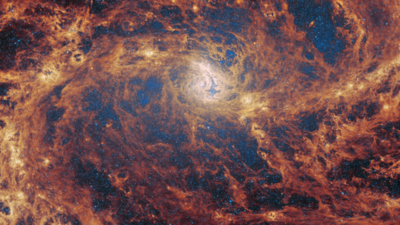The astronomers use James Webspace telescope Has yet revealed the desired strong evidence for a long time Super Mesio Black Hole The nearby spiral can lie in the center of Galaxy Messerra 83 (M83), also known as the Southern Pin Whale Galaxy.
This discovery was made using the middle infrared device (MIRI), which detected highly ionized neon gas, a sign that suggests the presence of one. Active Galaxy Nuclear (AGN)
M83 has surprised astronomers for decades. Although many major spiral galaxies like this are known to host AGNS, the previous attempt to detect anyone in M83 failed, possibly due to fading or inactive black hole. Now, according to the European Space Agency, the middle infrared sensitivity of the web has previously revealed the flags of ionized gas near the galaxy center.
“Our discovery of the ejaculation of the most iconized neonic emissions in the nucleus of M83 was unexpected.” Esa At the Space Telescope Science Institute in Baltimore. “These signatures need to generate large quantities of energy – can produce more common stars, than that, so far the presence of an AGN is strongly recommended, which is still ridiculous.”
My device, of which 50 % of ESA was supplied by MIRi European consortium, enabled scientists to see the thick dust veil in the core part of M83.
According to the ESA, the Web Mission NASA, the ESA and the Canadian Space Agency are cooperating, in which the ESA is also responsible for the launch service through Aryan 5.
“Before the web, we did not have tools to detect such unconscious and highly ionized gas signatures in the M83’s nucleus,” he said. He added, “Now … we are finally able to find the hidden depths of the galaxy.”
Although the evidence firmly points to an AGN, alternative explanations are still being detected. These include high trauma waves in the interstitial medium, possibly due to the galaxy talks. Astronomy.com notes that the rate of M83’s high -star composition can be left with another galaxy, potentially dwarf NGC 5253, or even within M83.
Linda Smith, co -author of the Space Telescope Science Institute, remarked, “For years, astronomers have searched for a black hole without success in M83. Now, we have a compulsory gesture that shows that someone can be present.” He added, “Our understanding of web galaxies is revolutionizing … this discovery has challenged past assumptions and opened new avenues to find it.”
The team plans to follow more observations using Atakama large millimeters/sub -meter array (Alma) and a large telescope (VLT). They will help to find out if the newly found emissions are really from the growing black hole or other high energy phenomena.
Since the web continues to show the invisible structure of the universe, astronomers are hopeful that more such mysteries will soon be revealed.
Subscribe to Updates
Get the latest creative news from FooBar about art, design and business.
Previous ArticleIndia’s Forex Reserves Rise By $1.57 Billion To $677.84 Billion
Related Posts
Add A Comment



